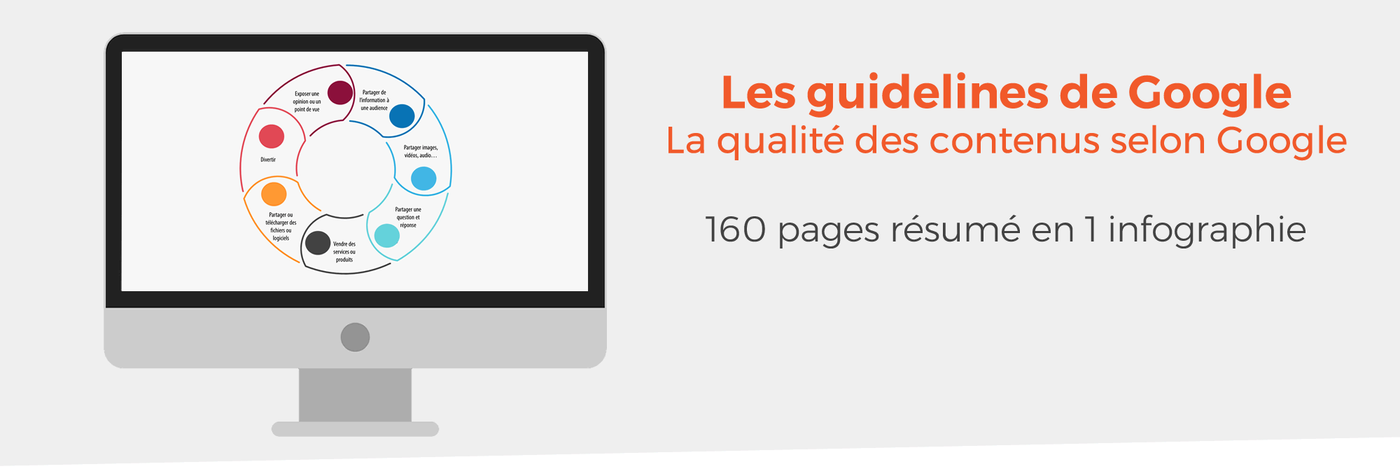Google released the latest version of its search quality evaluation guide in August 2018. A 160-page guide that I have condensed here into an easy-to-understand infographic.
These guidelines are representative of what search engine users want to see as quality results.
Webmasters and agencies can ensure that their web pages and content achieve the highest possible quality level to optimize their organic search ranking.
🖼 The infographic on content quality according to Google's guidelines

Note that:
- A page can get a high rating without reputation, but the opposite is impossible (a high score with a bad reputation).
- Content from a young site (less than 2 years old) without reputation cannot be considered low quality, however, older sites must have reviews.
🧐 Measure the quality of a page
Use this table to identify areas for improvement on your content or pages to get a better rating.
| Very low | Low | Medium | High | Very high | |
|---|---|---|---|---|---|
| Content Objective (the promise) | Missed | Missed | Achieved | Achieved | Achieved |
| Reputation | Negative | Negative | Positive | Positive | Very positive |
| Main Content Size (MC) | Very short | Short | Medium | Long | Very long |
| Main Content Quality (E-A-T Principle) | Low quality | Mediocre quality | Satisfactory quality | Good quality | Excellent quality |
| Secondary Content (SC) | Distracting (abusive ad) | Distracting (abusive ad) | Absent | Useful | Very useful |
| Webdesign | Poor | Poor | Poor | Functional | Functional |
| Website Information | Absent | Absent | Absent | Present | Present |
It's easy to imagine that Quality raters have a similar matrix to evaluate content. Google's evaluators will read the content, examine the page, images, or try to purchase a product to fully understand the website's objective. The more quality factors you include, the higher the rating will be. Conversely, the more incomplete, malicious, or deceptive the website is, the lower the rating. Average pages are a mix of high and low qualities.
How to read this table?
Let's take the example of a web page with the following characteristics:
- Content Objective (promise): Achieved
- Reputation: Very positive
- Main Content Size: long
- Main Content Quality: Good quality
- Secondary Content: Useful to the main content
- Webdesign: functional
- Website Information: absent
This web page will be rated as "Medium", even if it meets all the criteria for a "high or very high" rating. The absence of an "about" page penalizes its ranking.
❓ Why does Google need to measure content quality?
Google has confirmed that they use evaluators when they push an algorithm change to evaluate the quality of search results.
If Google sees in the result of these evaluations that the potential algo change improves search results, it is then likely that the change in question will be transferred to the main index of the search engine.
But if the evaluators assign a lower quality to the current results, Google will try to adjust the changes and possibly try a new version or not use it at all.
🤖 Does Google's AI use Quality Raters' data?
We know that Google uses machine learning at many levels in the search engine. This includes Google RankBrain, which is part of the algorithm and helps Google rank results for the 20% of daily queries that Google has never seen before.
Every time Google publishes new quality evaluation recommendations, one might rightly wonder if the search engine integrates the results of the Quality Raters into its Machine Learning algorithm.
My opinion on the matter is that the sample size, those of the evaluators, is too small to constitute a solid dataset for the constitution of the dataset.
The datasets needed for machine learning tend to be quite large, even if there is a significant number of quality evaluators (over 10,000 worldwide), it is far from the number for the constitution of a robust dataset to fulfill the search engine's mission.
Sources:
- Check out the guidelines for Google Search: https://static.googleusercontent.com/media/www.google.com/fr//insidesearch/howsearchworks/
assets/searchqualityevaluatorguidelines.pdf
Need to go further?
If you need to delve deeper into the topic, the editorial team recommends the following 5 contents:

